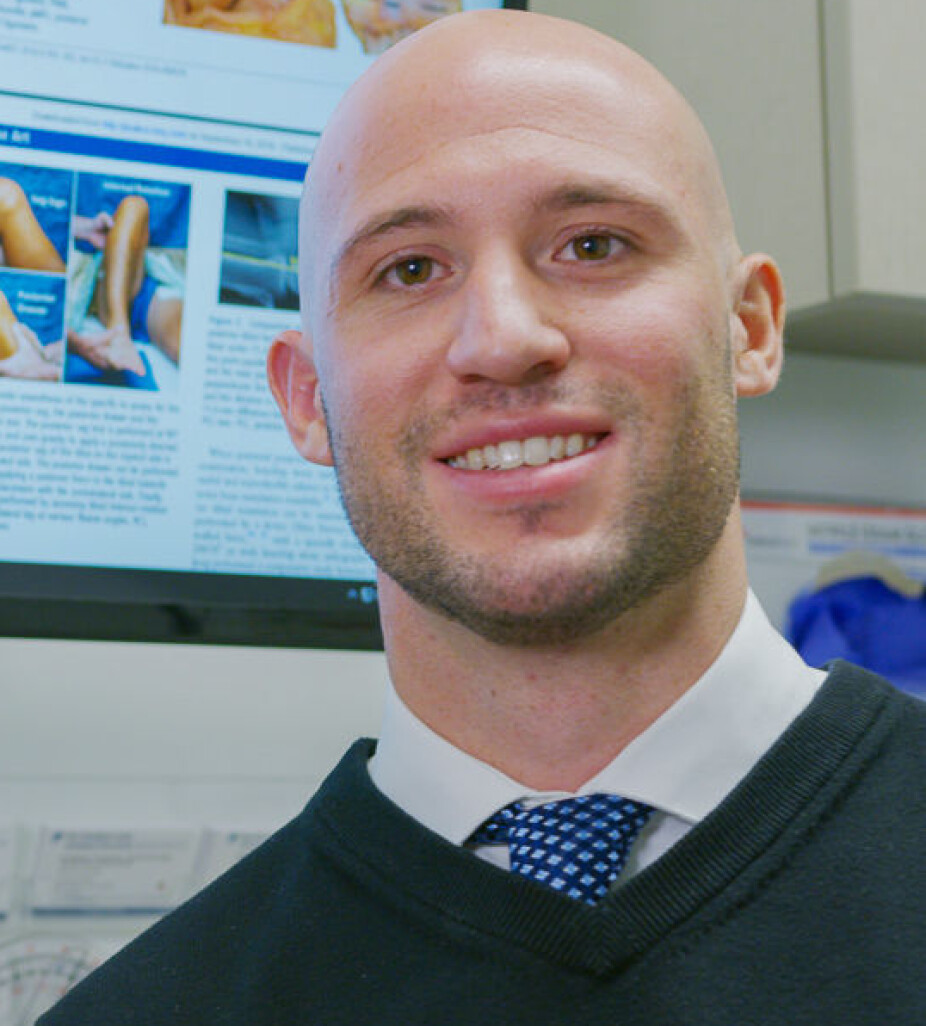This article was produced and financed by The Norwegian School of Sport Sciences - read more

New method can make injured knees like new again
A new method enables the detection and repair of previously undetected knee injuries. One in six people who sustain a meniscus injury also have this newly identified damage, which has led to everything from permanent pain to a need for prosthetics.
“Making a damaged knee as good as new is a pretty revolutionary thing,” says Nicholas DePhillipo at the Centre for Sports Injuries at the Norwegian School of Sports Sciences (NIH).
He has discovered that so-called meniscus-attachment injuries – or “meniscus ramp lesions» – are very common.
This type of injury has not previously been known, but one in six people who injure their meniscus also have this type of ramp injury, sometimes accompanied by other types of injuries to the knee.
DePhillipo has also discovered how to both identify and repair this injury, and thus get people on their feet again.
Because this type of meniscus ramp injury has not previously been known, it has obviously also been extremely difficult to diagnose and treat. Even when looking inside the knee, typically in connection with a keyhole procedure or using MRI (magnet resonance imaging), it has been difficult to identify this type of injury with any degree of certainty.
Quick and cheap to fix
DePhillipo’s findings mean that we now know about this type of injury and that we can identify and treat it.
“Using this knowledge, we can carry out and interpret MRI scans much better,” explains DePhillipo.

In order to find the damage in such cases, a special camera, an arthroscope, will be placed in a position that is not normally used. He says that even an MRI scan will not necessarily show everything, but that this is possible with keyhole surgery - now that they are aware of this type of injury.
“One bonus is that both the examination and the procedure can be performed at a day clinic. So, it is also cheap.”
Discovered through keyhole surgery

It was precisely during keyhole surgery that this "new" type of injury was discovered. One patient experienced pain and swelling in a knee after an injury, but during surgery they could see nothing wrong at the meniscus. Some more searching around the bone structure in the very joint revealed something, though: There was a tear in the affixion between the meniscus and the joint capsule.
"When we made the same damage to a dead knee and then checked with the same keyhole surgery, we found it again. In short this means that you now can repair something that no one before has ever found", says DePhillipo.
Why this type of injury has not been found before is probably due to two factors: The keyhole surgery instruments have not been good enough, and the surgeons have not searched enough to detect it.
Quickly back on one’s feet
“If injuries of this type are not quickly diagnosed and treated, the patient could suffer from pain for years, instead of being fully mobile,” states Nicholas DePhillipo.
Injuries of this type are treated by performing a keyhole procedure during which the meniscus and the capsule are sewn together. After the operation the injury will heal within a few weeks, and the patient can use his/her knee as normal after just three-four months.
"When everything has healed, the knee will function normally", states DePhillipo.
Serious for both the old and the young
The two sets of meniscus cartilage in each knee act as shock absorbers, but they are also important for keeping the knee stable. While damage to the actual meniscus is common in young people, poorly functioning worn meniscus in middle-aged people and the elderly is common, particularly after passing the age of 50.
Meniscus injuries are serious for both old and young people alike. Young people often have to give up sports. For old people this type of injury means that they become less mobile. It can also lead to considerable damage to the joint caused by wear and tear, resulting in the need for prosthetics. Regardless of age, these injuries are painful.
Useful for surgeons and physiotherapists
During the study DePhillipo not only anatomically identified and described this injury, he also created such injuries on models and showed that they lead to increased pressure on the cartilage on both the greater trochanter and the fibular head.
DePhillipo’s thesis provides surgeons with new knowledge which will result in better treatment of meniscus injuries. It will also provide physiotherapists with a better understanding of the limitations which affect re-training after such procedures.
“This new method can make knees like new again. I would say that this new knowledge is fairly revolutionary for knee surgeons and for everyone who can now regain their mobility,” says Nicholas DePhillipo.
Reference:
Nicholas DePhillipo has published a number of articles about his doctoral studies – se overview in PubMed.
He defended his doctoral thesis about meniscus ramp lesions at the NIH on 24 March.
———


































